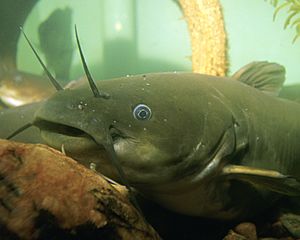Yellow bullhead facts for kids
Quick facts for kids Yellow bullhead |
|
|---|---|
 |
|
| Conservation status | |
| Scientific classification | |
| Synonyms | |
|
The yellow bullhead (Ameiurus natalis) is a type of catfish that does not have scales. It is a ray-finned fish, meaning its fins are made of bony spines connected by a thin web of skin.
Contents
About the Yellow Bullhead
The yellow bullhead is a medium-sized member of the catfish family. Its back can be yellow-olive or dark, sometimes with spots. Its sides are lighter and more yellowish. The bottom of its head and body are bright yellow, yellowish-white, or bright white.
Its tail fin is rounded. The fin on its underside (called the anal fin) is quite large. It has between 24 and 27 rays, which are like flexible bones.
How to Tell Them Apart
Yellow bullheads are sometimes confused with brown or black bullheads. You can easily tell a yellow bullhead apart by its white "whiskers," which are called barbels. The other bullhead types usually have darker barbels.
Yellow bullheads are not very big fish. They rarely weigh more than 2 lb (0.91 kg). However, some can grow up to four pounds. They usually range from 6 to 14 inches long and can live for up to 12 years.
What Yellow Bullheads Eat
Yellow bullheads are very hungry scavengers. This means they will eat almost anything they can find. They use their barbels, which have taste buds, to feel along the bottom of streams. This helps them find food.
They usually feed at night. Their diet includes many different plants and animals, both alive and dead. Common foods are worms, insects, snails, small fish, clams, and crayfish. They also eat other small water creatures, plants, and decaying animal parts. Yellow bullheads eat more water plants than black or brown bullheads do.
Where Yellow Bullheads Live
Yellow bullheads live at the bottom of bodies of water. They like areas with mud, rocks, sand, or clay. You can find them in slow-moving parts of rivers, calm backwaters, and quiet currents. They live in creeks, small to large rivers, and shallow parts of lakes and ponds.
Their homes can be very different. Some live in slow currents with dirty, polluted water that doesn't have much oxygen. Others live in faster currents with clean, clear water and lots of water plants. Fishermen often find them in slow creeks and rivers that have a gravel bottom.
Reproduction and Life Cycle
Yellow bullheads form pairs to have babies. Spawning, which is when they lay eggs, starts in mid-May or early June. Both the male and female fish help build the nest.
They usually use natural holes or make bowl-shaped dips in the ground. These nests are often near things like tree roots or sunken logs. The female lays between 300 and 7,000 eggs in a jelly-like mass. After the eggs are fertilized, the male protects them. He also fans the eggs constantly to keep them healthy.
The eggs hatch in five to 10 days. The young fish, called fry, are kept in tight groups by the male. Both parents protect the fry until they are about two inches long. By the time they are one year old, they grow to about three inches. Yellow bullheads become old enough to have their own babies when they are two or three years old. At this age, they are at least 140 millimeters (about 5.5 inches) long.
Where Yellow Bullheads Are Found
Yellow bullheads live across the central and eastern parts of the United States. Their range goes from central Texas up to North Dakota. It also stretches east through the Great Lakes region to the East Coast.
They have also been moved to the western United States. You can now find them as far north as Washington state.
Fishing for Yellow Bullheads
Yellow bullheads are considered a minor game fish. This means people do fish for them, but they are not as popular as some other catfish. Their meat is said to be sweet and taste good. However, in summer, their meat can become soft.
You can catch them using natural baits like worms, crickets, or chicken liver. Fishermen usually put the bait on the bottom of the water at night.
See also
 In Spanish: Ameiurus natalis para niños
In Spanish: Ameiurus natalis para niños


